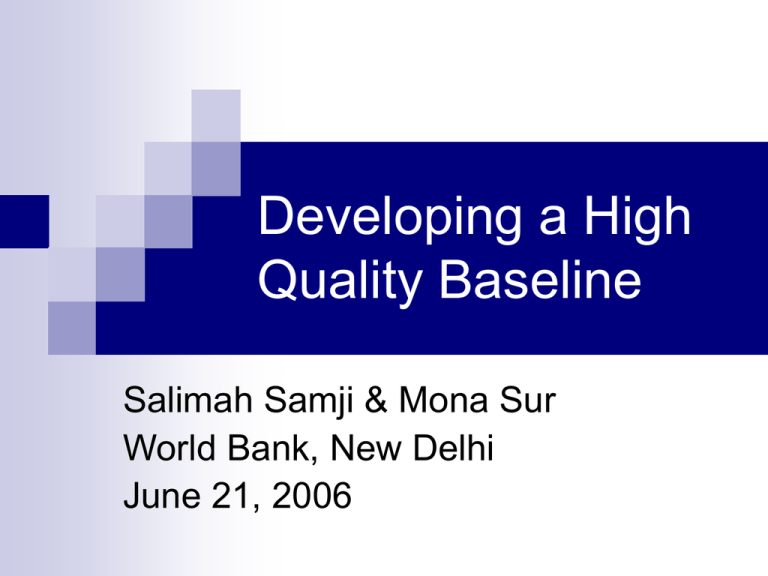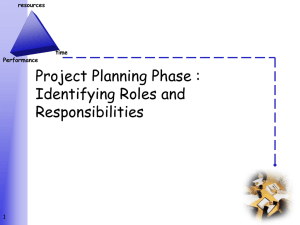Developing a High Quality Baseline
advertisement

Developing a High Quality Baseline Salimah Samji & Mona Sur World Bank, New Delhi June 21, 2006 Overview What is a baseline? Why you should care The phases of conducting a baseline The errors to avoid in each phase How to manage the common errors Elements of a baseline survey (TOR) What is a baseline? Fixing the time at the base – a benchmark from which you measure progress Snapshot of indicators at a time Instrument used to: Test hypotheses of project (assess results) Planning (refine targeting, indicators to monitor) Why you should care … To identify whether there were any benefits for the investments made Were objectives met? What factors explain the result? How can the program be improved? Compare alternative models to get the biggest bang for your buck To inform next generation projects Evidence-based policy making – demonstration effect for government The phases of conducting a baseline Design Implementation – actual survey Data entry and analysis Report writing Phase 1: Design Phase P1: Check-list Clear objectives (what is the problem?) Clear idea of how you will achieve the objectives (causal chain or hypotheses) Clear and measurable indicators Clear (precise and unambiguous) Relevant (to objectives) Monitorable Example of a causal chain Example: APDPIP Impact Outcomes Higher income levels Increased use of credit for income generation, Loan repayment rates Outputs Number of SHGs, decreased input prices Activities Forming, federating and organizing SHGs Inputs Facilitators, Revolving fund (credit) P1: Check-list (cont’d) Design survey instrument – keep it simple and related to the objectives and hypotheses you want to test Link surveys to GIS – use consistent units Select controls/counterfactuals to attribute change (causality) Timing of baseline Before project (what if project never materializes)? 2 years into the project (intervention has begun)? Other factors (seasonality) P1: Check-list (cont’d) Sampling strategy Random allows inferences about a population Random Stratified random (include groups which could be excluded) Non-random – use a group smaller than the population Introduces selection bias. Note: every stratification introduces a level of bias. Population Size Sample Size 10 10 50 44 100 80 500 217 1,000 278 3,000 341 50,000 381 1,00,000 385 P1: Check-list (cont’d) Over sample for attrition Design the database system for data entry Translate the questionnaire Back translate to verify Provide adequate training on The objectives and importance of the study How the sections are linked and what the questions mean Attend the training if possible (stay involved) P1: Check-list (cont’d) Test the questionnaire Ask yourself, can you answer these questions? Are they relevant to the outcomes? Will they be understood? Field test: To test both how the surveyor administers the instrument AND how the respondent understands the question. P1: Why it is important to field test (i) When asking a question about the level of awareness, the surveyor used a word that could mean awareness or knowledge – the respondent understood it to mean education. : The question was: “Ram/ Gita knows about everything that happens (vikas) in the village. For instance, they know [the name of the sarpanch, when and where the Gram Panchayat meets, nature and type of development work in village, etc.]” P1: Why it is important to field test (ii) CASE STUDY: Domestic Violence Study in India “In studying domestic violence, a question in the survey instrument asked if female respondents had ever been beaten by their husbands in the course of their marriage. Only 22 per cent of the women responded positively to this question – a domestic violence rate much lower than studies in Britain and the US had shown. In probing the issue with indepth interviews we discovered that the women had interpreted the word ‘beating’ to mean extremely severe beating – when they had lost consciousness or were bleeding profusely and needed to be taken to the hospital. Hair pulling, ear twisting, etc, which were thought to be more everyday occurrences, did not qualify as beating. Reponses to a broader version of the abuse question, comparable to the questions asked in the US and UK surveys, elicited a 70 per cent positive response.” Source: Vijayendra Rao (1998) – “Wife-Abuse, Its Causes and Its Impact on Intra-Household Resource Allocation in Rural Karnataka” Phase 2: Implementation What would you do if you … Were a city person who didn’t speak the local language very well Had to travel to several villages and spend hours asking people questions that have no relevance to you. Were paid a small sum per questionnaire Not monitored by supervisors This is not your full time job The answer is simple Sit at home or in a bar and fill out the questionnaires!! P2: Providing incentives and motivation Sub-contracting surveyors from the state who speak the language Include women surveyors Include a supervisor who conducts data scrutiny If possible pay reasonable wages Randomly verify questionnaires to reduce the likelihood of false responses (inform them beforehand - during the training) Phase 3: Data Entry and Analysis P3: Check-list Data Entry Make the data entry system as fool proof as possible - has unique identifiers to link both household, village and GIS data Ensure database allows for merging of data Do not change/erase data on questionnaires Raw data should always be input as is, changes can then be made in the database software (programatically) with documentation P3: Check-list (cont’d) Often data entry is contracted out. Name variables corresponding to the question and section in the questionnaire – include a dictionary Code descriptive answers (to facilitate analysis) All fields should be filled (NA or NR) Units should be uniform by district Totals calculated by formula not from summary column Consistency checks – check for missing entries, wrong entries, sample statistics, patterns (queries should be inbuilt) Validity checks – similar questions in different places on the questionnaire (RCH example) P3: Check-list (cont’d) Data analysis Common mistakes in interpreting data No analysis! No correlations, crosstabs, statistical significance levels or regressions Over generalizing the results Mis-reporting statistics Using % when the numbers are small Attributing causality when it is not demonstrated Phase 4: Report Writing P4: What the report should be … Simple, Clear and Relevant State limitations (attribution, causality) Major findings should be upfront Focus on quality rather than quantity Technical details in an appendix Should always include the questionnaire in the appendix ask for electronic copy of data Request copies of filled out surveys Essential if you change consultants at midterm or want to conduct internal analysis to compare modes of delivery (data lost example). How to manage the common errors Phase 1: Design objectives and hypotheses – know what you want to test Identify a person in your unit who will manage this process Write a good TOR, remember the baseline determines the quality of your panel You can add questions as project evolves but cannot change questionnaire – threat to internal validity Identify consultants Clear Procurement – focus on quality not the cheapest bid “if you throw peanuts you’ll attract monkeys” Ideally you should have a black-list of organizations How to manage the common errors Phase 2: Implementation Organize an impact evaluation workshop if necessary Randomly verify questionnaires to reduce the likelihood of false responses (no filling it in a bar) Pay reasonable wages to surveyors (if possible) Show the client and firm that you care How to manage the common errors Phase 3: Data entry and analysis Double-data entry (2 separate organizations and verify. Payment based on quality of data entry) Select 15 questionnaires at random and check data entry – person in your unit managing Check data quality (consistency and validity checks) Hold an IE workshop to build data analysis capacity (if necessary) How to manage the common errors Phase 4: Report writing Agree on an outline beforehand Dedicate a chapter on indicators you are tracking Focus on quality not quantity Think “Big Picture” Elements of a Baseline Survey Terms of References 1. 2. 3. 4. 5. 6. 7. 8. 9. 10. 11. Background: Project objectives and components Survey design: Consult a sampling expert!!! Survey instruments Guidance on survey implementation Data processing and analysis Staffing Duration and time schedule Submission of reports and datasets Support to the firm Budget & Payment Schedule Annexes: Draft questionnaires, Results Framework Baseline Survey Design: Typical Tasks for Consultants Recommend the methodology for sampling Calculate the optimal sample size Develop the sample frame and select the sample The final sample and details of the statistical methodology used to select the sample need to be cleared by the project Construct the sample weights and provide documentation on the methodology used to construct the weights Survey Instruments: Questionnaires Design or refinement and adaptation of the data collection instruments Specify levels of data collection Length of questionnaires Prepare all support documentation including coding guides, interviewer and supervisor manuals and the data entry manual Translation and back-translation Skip patterns, coding open ended questions Guidance on Survey Implementation Implementation plan Selection and training of field workers: specify minimum duration of training Pilot testing should be explicitly specified in ToR Responsibility for all field operations, including logistical arrangements for data collection and obtaining household consent lies with Consultants. Ask for field-work progress reports (biweekly/monthly) Staffing Sampling expert/statistician Technical specialists as relevant Economist Sociologist. Core survey staff: the survey manager, the field manager, the data manager Enumerators, supervisors and data entry staff Baseline Report & Data Explicitly request final electronic datasets—with complete documentation. Agree on outline of baseline report upfront. Managing a Baseline Survey Consult the experts—survey specialist and sampling specialist and develop the ToR in consultation. Selection committee should include a survey expert and social scientists in addition to technical experts. You can never over-supervise!!! Hire third-party supervision consultant if needed. Question the data and the findings. Lets recap what you have learned The devil lies in the detail Be watchful No pain, No gain








